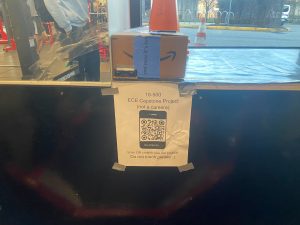After meeting with gym administrators this week, we have eliminated the camera system from our project. Our proposal for the system up for our people counting model was rejected. We are currently waiting for approval from gym administrators with a new approach using two proximity sensors to count people entering the gym. As of now, no costs have been incurred from this change. Our schedule change is pending the approval of the two-sensor people counter from gym administrators.
Right now, our biggest risk that could jeopardize our project is not getting approval for our people counting module being set up in the U.C. gym. We are managing this risk by staying in contact with UC gym administrators, and in the case we have it rejected we have data that UC gym employees have given us access to that can be used to train a rough model. We also plan on relying on surveying people on the time they use the gym in the worst-case scenario.
Part A was written by Max Adams
Considering public health, our product solution addresses the problems of overcrowding in the gym and the effects it has on aspiring and current gym goers. Current gym goers will be able to pick better times to exercise, improving their physical fitness. Our solution also applies to those who may be reluctant to go to the gym because they are anxious about it being crowded, providing a medium where they can see how crowded it is and pick times when they may feel less anxious when it is not crowded. This will help them both physiologically and psychologically, enabling them to exercise while providing the comfort of knowledge in the crowding state of the gym space.
Part B was written by Sid Sapra
Our gym tracking app meets the need for real-time insights into gym occupancy and equipment usage which allows it to have a large social impact on individuals focusing on fitness. By predicting crowd levels and machine availability, it enables users to plan their workouts efficiently, fostering a sense of community by promoting collaborative sharing of equipment. This not only streamlines the workout experience but also addresses social factors such as varying cultural attitudes towards exercise and socioeconomic backgrounds, contributing to a more inclusive and connected fitness community.
Part C was written by Derek Kim
Our solution addresses the need for efficient gym space management by displaying real-time gym occupancy data to users. By integrating sensors into gym benches and leveraging machine learning algorithms to analyze occupancy patterns, our solution optimizes the use of gym facilities and enhances the overall experience for gym-goers. However, in our specific case, this would be a service that we would be providing to CMU students which means that it is not a product that we are selling.
However, this solution can be scaled to fit the needs of commercial gyms since commercial gyms often have occupancy issues. In this case, our solution offers several economic benefits. Making real-time gym data available to consumers can help combat congestion in the gym space which will allow for an increase in gym capacity each day. Additionally, this service would be very helpful for people who are busy and need to plan their gym sessions during the day; this service would attract many more customers who often find it hard to make time to go to the gym, especially during high occupancy hours. Finally, our product would give access to historical data on gym usage which allows gym management to make more data-driven decisions to further improve their efficiency. Overall, our solution provides economic benefits by optimizing resource utilization and improving consumer experience.







